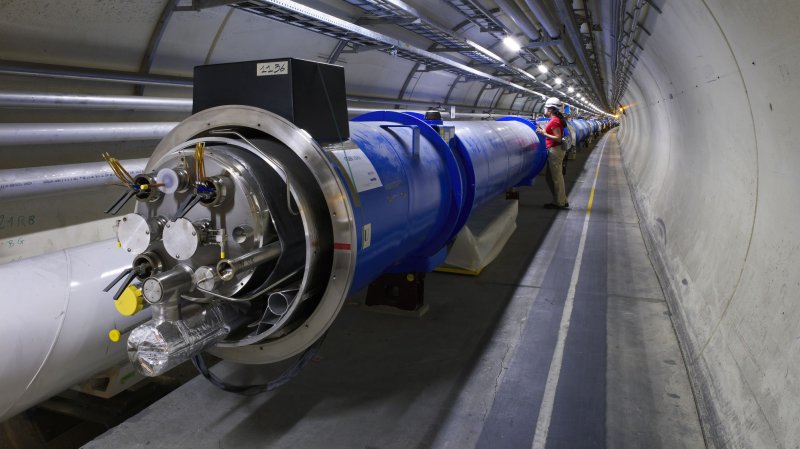Two Large Hadron Collider (LHC) magnets are seen before they are connected together. The LHC simulates mini-Big Bangs allowing scientists to study theories of the dawn of time. UPI/Maximilien Brice/CERN
With the July 4th announcement of the possible -- wait, make that probable -- no, actually, make that the almost certain confirmation of the existence of the Higgs boson, the so-called "God particle," physicists find themselves facing a fundamental question.
Does the discovery of the last member of the particle "zoo," the last piece of the puzzle of the fundamental nature of matter, mean that physicists have reached the end of their field's ultimate quest, time to pick up their lunchboxes and go home?
Or does the existence of the Higgs, although certainly an ultimate answer of sorts, just raise a thousand new questions, a thousand new avenues of research in quest of new, possible deeper answers?
First, a little history.
It was 1964 when British physicist Peter Higgs first proposed a theoretical model that predicted the particle given his name.
In that model, the existence of the Higgs boson and the associated Higgs field explain why the other elementary particles in the Standard Model of physics have mass, obtaining it by continuous interaction with this field.
The Standard Model lays out the theory of electromagnetic, weak, and strong nuclear interactions which control the properties of the known subatomic particles.
The Higgs boson was seen to be the foundation of the model and the search for it the most important effort in the field of particle physics.
The search was conducted in the same way that had identified almost all other sub-atomic particles -- by using accelerators to propel charged particles to high speeds and guiding them to collisions, then examining the bits and pieces of ever smaller particle flung out by the collisions.
The search would be difficult as the theory of the Higgs held it would have no intrinsic spin, no electric charge, and would be very unstable, decaying almost immediately after its creation in a particle collision.
Accelerators around the world began the search at higher and higher energies in the hope that a collision would one day produce evidence of the Higgs at the extremely high energy levels where it was predicted it would show itself.
Enter the Large Hadron Collider at CERN, the European nuclear research center.
Two research teams, the CMS and the ATLAS collaborations, have spent years in the search for the Higgs and on July 4 announced that analysis of data gathered in their experiments was consistent with the Higgs boson, at the energy levels posited for it.
But having achieved the particle physics equivalent of scaling Mount Everest or putting a man on the moon, what now?
That depends on whether it is truly the Higgs that scientists believe has been discovered.
The CERN researchers have said only that the new particle is "consistent" with the Higgs boson, and that more data and analysis -- and perhaps even more experiments -- would be required before the particle could be positively identified.
In other words, it could be an impostor, or a Higgs "lookalike."
Not that physicists are particularly dismayed by the prospect, which would mean more questions, more research, and the knowledge that physics, as a field, has much more work to do.
"A Higgs lookalike would propel us into a new realm of experimentation and physics understanding," Caltech physics Professor Harvey Newman said.
"One of the most exciting aspects of this observation is that the road remains open for a vast range of 'lookalike' alternatives, where any deviation from the Standard Model would point the way to the existence of other new particles or forces of nature."
So whether the Higgs boson represents an answer or just more questions, particle physicists are ready to grapple with both.
Not time to put away the lunchboxes, it would seem.















